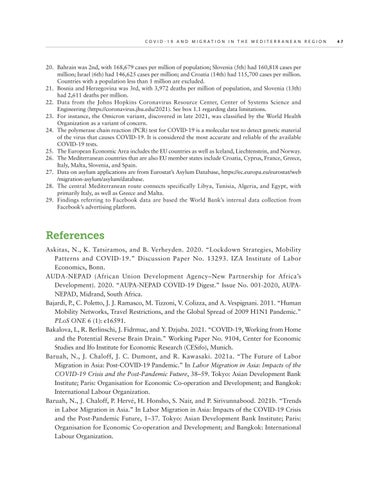C OVID - 1 9 a n d M i g r a t i o n i n t h e M e d i t e r r a n e a n R e g i o n
20. Bahrain was 2nd, with 168,679 cases per million of population; Slovenia (5th) had 160,818 cases per million; Israel (6th) had 146,625 cases per million; and Croatia (14th) had 115,700 cases per million. Countries with a population less than 1 million are excluded. 21. Bosnia and Herzegovina was 3rd, with 3,972 deaths per million of population, and Slovenia (13th) had 2,611 deaths per million. 22. Data from the Johns Hopkins Coronavirus Resource Center, Center of Systems Science and Engineering (https://coronavirus.jhu.edu/2021). See box 1.1 regarding data limitations. 23. For instance, the Omicron variant, discovered in late 2021, was classified by the World Health Organization as a variant of concern. 24. The polymerase chain reaction (PCR) test for COVID-19 is a molecular test to detect genetic material of the virus that causes COVID-19. It is considered the most accurate and reliable of the available COVID-19 tests. 25. The European Economic Area includes the EU countries as well as Iceland, Liechtenstein, and Norway. 26. The Mediterranean countries that are also EU member states include Croatia, Cyprus, France, Greece, Italy, Malta, Slovenia, and Spain. 27. Data on asylum applications are from Eurostat’s Asylum Database, https://ec.europa.eu/eurostat/web /migration-asylum/asylum/database. 28. The central Mediterranean route connects specifically Libya, Tunisia, Algeria, and Egypt, with primarily Italy, as well as Greece and Malta. 29. Findings referring to Facebook data are based the World Bank’s internal data collection from Facebook’s advertising platform.
References Askitas, N., K. Tatsiramos, and B. Verheyden. 2020. “Lockdown Strategies, Mobility Patterns and COVID-19.” Discussion Paper No. 13293. IZA Institute of Labor Economics, Bonn. AUDA-NEPAD (African Union Development Agency–New Partnership for Africa’s Development). 2020. “AUPA-NEPAD COVID-19 Digest.” Issue No. 001-2020, AUPANEPAD, Midrand, South Africa. Bajardi, P., C. Poletto, J. J. Ramasco, M. Tizzoni, V. Colizza, and A. Vespignani. 2011. “Human Mobility Networks, Travel Restrictions, and the Global Spread of 2009 H1N1 Pandemic.” PLoS ONE 6 (1): e16591. Bakalova, I., R. Berlinschi, J. Fidrmuc, and Y. Dzjuba. 2021. “COVID-19, Working from Home and the Potential Reverse Brain Drain.” Working Paper No. 9104, Center for Economic Studies and Ifo Institute for Economic Research (CESifo), Munich. Baruah, N., J. Chaloff, J. C. Dumont, and R. Kawasaki. 2021a. “The Future of Labor Migration in Asia: Post-COVID-19 Pandemic.” In Labor Migration in Asia: Impacts of the COVID-19 Crisis and the Post-Pandemic Future, 38–59. Tokyo: Asian Development Bank Institute; Paris: Organisation for Economic Co-operation and Development; and Bangkok: International Labour Organization. Baruah, N., J. Chaloff, P. Hervé, H. Honsho, S. Nair, and P. Sirivunnabood. 2021b. “Trends in Labor Migration in Asia.” In Labor Migration in Asia: Impacts of the COVID-19 Crisis and the Post-Pandemic Future, 1–37. Tokyo: Asian Development Bank Institute; Paris: Organisation for Economic Co-operation and Development; and Bangkok: International Labour Organization.
4 7

